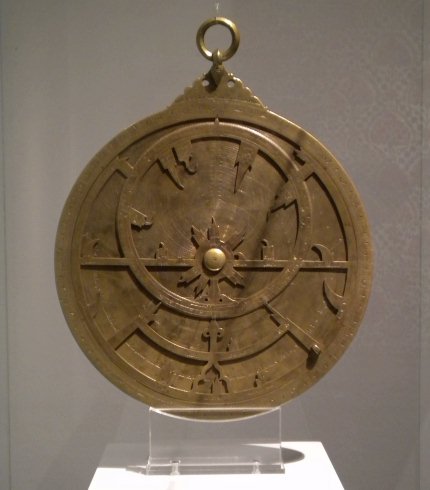

![]() Das
Museum für
Islamische Kunst
ist derzeit im ersten Obergeschoss des Pergamon-Museums untergebracht. Dort, gleich im
Eigangsbereich findet man das oben abgebildete Astrolabium als Exponat vor. Die
Objektbeschreibung weist darauf hin, dass es vom Astronom und Poet
Hibat Allah al-Bagdādī
im Irak um 1120 unserer Zeitrechnung gefertigt wurde. Der Entwurf stammt allerdings vom
Mathematiker und Astronomen Abū
Ğacfar al-Hāzin (ca. 900 - ca. 971). Dieses
Instrument ist das einzige seiner Art und aus Bronze erstellt.
Das
Museum für
Islamische Kunst
ist derzeit im ersten Obergeschoss des Pergamon-Museums untergebracht. Dort, gleich im
Eigangsbereich findet man das oben abgebildete Astrolabium als Exponat vor. Die
Objektbeschreibung weist darauf hin, dass es vom Astronom und Poet
Hibat Allah al-Bagdādī
im Irak um 1120 unserer Zeitrechnung gefertigt wurde. Der Entwurf stammt allerdings vom
Mathematiker und Astronomen Abū
Ğacfar al-Hāzin (ca. 900 - ca. 971). Dieses
Instrument ist das einzige seiner Art und aus Bronze erstellt.
Abū Ğacfar al-Hāzin - es gibt mehrere verschiedene Schreibweisen seines Namens - hat gemäß [1] und [2, S. 3]) verschiedene Schriften mathematischen Inhalts und Kommentare verfasst.
Das Foto wurde im August 2011 aufgenommen.
![]() Actually the
Museum of
Islamic Art is established in the first upper floor of the Pergamon Museum. Near the
entrance you will find the astrolab shown at the top of this page. The description of this
exhibit states the following information:
Actually the
Museum of
Islamic Art is established in the first upper floor of the Pergamon Museum. Near the
entrance you will find the astrolab shown at the top of this page. The description of this
exhibit states the following information:
- It was created by the astronomer and poet Hibat Allah al-Bagdādī
in Iraq about 1120 (of the Christian calendar).
- The design originates to Abū
Ğacfar al-Hāzin (about 900 - about 971).
- The astrolab is the only one of its kind.
- It is manufactured of bronze.
Abū Ğacfar al-Hāzin - there are different variants of his name - wrote several papers concerning mathematics as well as some comments (confer e. g. [1] and [2, p. 3]).
The photograph was taken in August 2011.
| [1] | Gottwald, Siegfried, Ilgauds, Hans-Joachim and Schlote, Karl-Heinz (Eds.): Lexikon bedeutender Mathematiker, 1. ed., Verlag Harri Deutsch, Thun - Frankfurt am Main, 1990, ISBN 3-8171-1164-9 | |
| [2] | Selin, Helaine: Encyclopaedia of the history of science, technology, and medicine in non-western cultures, Kluwer Academic Publishers, Dordrecht, 1997 |
| Back to the main page | Created by Wolfgang Volk in August 2011 |